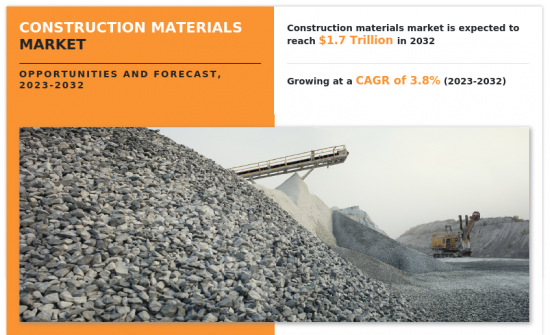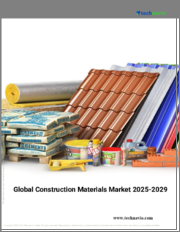
|
시장보고서
상품코드
1365796
건축자재 시장 : 재료 유형별, 최종 용도별 - 세계 기회 분석 및 산업 예측(2023-2032년)Construction Materials Market By Material Type (Aggregates, Cement, Bricks and Blocks, Metals, Others), By End-use (Residential, Commercial, Industrial): Global Opportunity Analysis and Industry Forecast, 2023-2032 |
||||||
건축자재 시장은 2022년 1조 2,000억 달러로 평가되었고, 2023년부터 2032년까지 연평균 복합 성장률(CAGR) 3.8%로 성장하여 2032년에는 1조 7,000억 달러에 달할 것으로 예상됩니다.

건축자재는 인프라를 구축하는 데 사용되는 물질입니다. 건물은 나무, 자갈, 점토, 모래, 뿌리, 나뭇잎 등 자연에 존재하는 다양한 재료로 만들어집니다. 벽돌, 시멘트, 부식성 첨가제, 콘크리트, 목재, 세라믹, 강철, 재활용 재료, 고분자, 유리섬유, 라면 흙, 대나무, 역청 물질, 첨단 건축자재 등이 건축에 사용되는 주요 원자재 중 하나입니다.
저렴한 주택에 대한 수요가 예측 기간 동안 시장 성장을 가속할 것으로 예상됩니다. 많은 지역에서 주택 부족으로 인해 건설 활동이 활발해지면서 건축자재에 대한 수요가 증가하고 있습니다. 또한 경제 성장에 따라 사무실, 쇼핑몰, 복합 엔터테인먼트 시설과 같은 상업 공간에 대한 수요가 증가하여 건축자재 소비 증가로 이어질 것입니다. 또한, 스마트시티와 지능형 인프라 개발은 에너지 효율이 높은 건물, 데이터 통신, 센서 등 첨단 재료의 통합을 필요로 합니다.
목차
제1장 서론
제2장 주요 요약
제3장 시장 개요
- 시장 정의와 범위
- 주요 조사 결과
- 영향요인
- 주요 투자 기회
- Porter의 Five Forces 분석
- 시장 역학
- 성장 촉진요인
- 성장 억제요인
- 기회
- 시장에 대한 COVID-19의 영향 분석
- 주요 규제 분석
- 특허 상황
- 가격 분석
제4장 건축자재 시장 : 재료 유형별
- 개요
- 골재
- 시멘트
- 벽돌 및 블록
- 금속
- 기타
제5장 건축자재 시장 : 최종 용도별
- 개요
- 주택
- 상업용
- 산업용
제6장 건축자재 시장 : 지역별
- 개요
- 북미
- 미국
- 캐나다
- 멕시코
- 유럽
- 독일
- 프랑스
- 이탈리아
- 영국
- 스페인
- 기타
- 아시아태평양
- 중국
- 인도
- 일본
- 한국
- 호주
- 기타
- 라틴아메리카/중동 및 아프리카
- 브라질
- 사우디아라비아
- 남아프리카공화국
- 기타
제7장 경쟁 구도
- 서론
- 주요 성공 전략
- 주요 10개사의 제품 매핑
- 경쟁 대시보드
- 경쟁 히트맵
- 주요 기업의 포지셔닝, 2022년
제8장 기업 개요
- Ambuja Cements Ltd
- ArcelorMittal
- Grasim Industries Limited
- CRH
- LIXIL Corporation
- Knauf Digital GmbH
- CEMEX, S.A.B. de C.V.
- Boral
- Sika AG
- Holcim
According to a new report published by Allied Market Research, titled, "Construction Materials Market," The construction materials market was valued at $1.2 trillion in 2022, and is projected to reach $1.7 trillion by 2032, growing at a CAGR of 3.8% from 2023 to 2032.

Construction materials are the substances used for the building of an infrastructure. The buildings are made from a broad range of naturally occurring materials, such as wood, pebbles, clays, sand, roots and leaves. Bricks, cement, corroding additives, concrete, timber, ceramic, steel, recycled materials, polymers, glass fibers, rammed earth, bamboo, bituminous material and advanced building materials are among the major raw materials used for construction.
The demand for affordable housing is expected to propel market growth during the forecast period. In many regions, there is a shortage of housing units, leading to increased construction activity and construction materials demand. Besides, as economies grow, the demand for commercial spaces such as offices, shopping malls, and entertainment complexes increases, leading to higher consumption of construction materials. Also, the development of smart cities and intelligent infrastructure necessitates the integration of advanced materials for energy-efficient buildings, data communication, and sensors.
In addition, the growth of industries such as manufacturing, logistics, and warehousing requires construction of new industrial facilities, driving the demand for construction materials. However, the cost fluctuation associated with construction materials is expected to act as a major restraint for market growth. Nevertheless, growing demand for green construction materials is expected to offer lucrative market growth opportunities in coming years.
The construction materials market is segmented on the basis of material type, end-use, and region. By material type, the market is categorized into aggregates, cement, bricks and blocks, metals, and others. By end-use, the construction materials market is classified into residential, commercial, and industrial. By region, the market is analyzed across North America, Europe, Asia-Pacific, and LAMEA.
Key players in the construction materials industry include Ambuja Cements Ltd; ArcelorMittal; Grasim Industries Limited; LIXIL Corporation; Sika AG; CRH; Knauf Digital GmbH; CEMEX, S.A.B. de C.V.; Holcim; and Boral.
Key Benefits For Stakeholders
- This report provides a quantitative analysis of the market segments, current trends, estimations, and dynamics of the construction materials market analysis from 2022 to 2032 to identify the prevailing construction materials market opportunities.
- The market research is offered along with information related to key drivers, restraints, and opportunities.
- Porter's five forces analysis highlights the potency of buyers and suppliers to enable stakeholders make profit-oriented business decisions and strengthen their supplier-buyer network.
- In-depth analysis of the construction materials market segmentation assists to determine the prevailing market opportunities.
- Major countries in each region are mapped according to their revenue contribution to the global market.
- Market player positioning facilitates benchmarking and provides a clear understanding of the present position of the market players.
- The report includes the analysis of the regional as well as global construction materials market trends, key players, market segments, application areas, and market growth strategies.
Additional benefits you will get with this purchase are:
- Quarterly Update and* (only available with a corporate license, on listed price)
- 5 additional Company Profile of client Choice pre- or Post-purchase, as a free update.
- Free Upcoming Version on the Purchase of Five and Enterprise User License.
- 16 analyst hours of support* (post-purchase, if you find additional data requirements upon review of the report, you may receive support amounting to 16 analyst hours to solve questions, and post-sale queries)
- 15% Free Customization* (in case the scope or segment of the report does not match your requirements, 20% is equivalent to 3 working days of free work, applicable once)
- Free data Pack on the Five and Enterprise User License. (Excel version of the report)
- Free Updated report if the report is 6-12 months old or older.
- 24-hour priority response*
- Free Industry updates and white papers.
Possible Customization with this report (with additional cost and timeline talk to the sales executive to know more)
- Additional company profiles with specific to client's interest
- Additional country or region analysis- market size and forecast
- SWOT Analysis
Key Market Segments
By Material Type
- Aggregates
- Cement
- Bricks and Blocks
- Metals
- Others
By End-use
- Residential
- Commercial
- Industrial
By Region
- North America
- U.S.
- Canada
- Mexico
- Europe
- Germany
- France
- Italy
- UK
- Spain
- Rest of Europe
- Asia-Pacific
- China
- India
- Japan
- South Korea
- Australia
- Rest of Asia-Pacific
- LAMEA
- Brazil
- Saudi Arabia
- South Africa
- Rest of LAMEA
Key Market Players:
- ArcelorMittal
- Grasim Industries Limited
- Sika AG
- Boral
- Knauf Digital GmbH
- Ambuja Cements Ltd
- LIXIL Corporation
- CRH
- Holcim
- CEMEX, S.A.B. de C.V.
TABLE OF CONTENTS
CHAPTER 1: INTRODUCTION
- 1.1. Report description
- 1.2. Key market segments
- 1.3. Key benefits to the stakeholders
- 1.4. Research Methodology
- 1.4.1. Primary research
- 1.4.2. Secondary research
- 1.4.3. Analyst tools and models
CHAPTER 2: EXECUTIVE SUMMARY
- 2.1. CXO Perspective
CHAPTER 3: MARKET OVERVIEW
- 3.1. Market definition and scope
- 3.2. Key findings
- 3.2.1. Top impacting factors
- 3.2.2. Top investment pockets
- 3.3. Porter's five forces analysis
- 3.3.1. Low bargaining power of suppliers
- 3.3.2. Low threat of new entrants
- 3.3.3. Low threat of substitutes
- 3.3.4. Low intensity of rivalry
- 3.3.5. Low bargaining power of buyers
- 3.4. Market dynamics
- 3.4.1. Drivers
- 3.4.1.1. Rise in population and urbanization
- 3.4.1.2. Infrastructure development
- 3.4.1. Drivers
- 3.4.2. Restraints
- 3.4.2.1. Cost fluctuations
- 3.4.3. Opportunities
- 3.4.3.1. Growing demand for green construction materials
- 3.5. COVID-19 Impact Analysis on the market
- 3.6. Key Regulation Analysis
- 3.7. Patent Landscape
- 3.8. Pricing Analysis
CHAPTER 4: CONSTRUCTION MATERIALS MARKET, BY MATERIAL TYPE
- 4.1. Overview
- 4.1.1. Market size and forecast
- 4.2. Aggregates
- 4.2.1. Key market trends, growth factors and opportunities
- 4.2.2. Market size and forecast, by region
- 4.2.3. Market share analysis by country
- 4.3. Cement
- 4.3.1. Key market trends, growth factors and opportunities
- 4.3.2. Market size and forecast, by region
- 4.3.3. Market share analysis by country
- 4.4. Bricks and Blocks
- 4.4.1. Key market trends, growth factors and opportunities
- 4.4.2. Market size and forecast, by region
- 4.4.3. Market share analysis by country
- 4.5. Metals
- 4.5.1. Key market trends, growth factors and opportunities
- 4.5.2. Market size and forecast, by region
- 4.5.3. Market share analysis by country
- 4.6. Others
- 4.6.1. Key market trends, growth factors and opportunities
- 4.6.2. Market size and forecast, by region
- 4.6.3. Market share analysis by country
CHAPTER 5: CONSTRUCTION MATERIALS MARKET, BY END-USE
- 5.1. Overview
- 5.1.1. Market size and forecast
- 5.2. Residential
- 5.2.1. Key market trends, growth factors and opportunities
- 5.2.2. Market size and forecast, by region
- 5.2.3. Market share analysis by country
- 5.3. Commercial
- 5.3.1. Key market trends, growth factors and opportunities
- 5.3.2. Market size and forecast, by region
- 5.3.3. Market share analysis by country
- 5.4. Industrial
- 5.4.1. Key market trends, growth factors and opportunities
- 5.4.2. Market size and forecast, by region
- 5.4.3. Market share analysis by country
CHAPTER 6: CONSTRUCTION MATERIALS MARKET, BY REGION
- 6.1. Overview
- 6.1.1. Market size and forecast By Region
- 6.2. North America
- 6.2.1. Key market trends, growth factors and opportunities
- 6.2.2. Market size and forecast, by Material Type
- 6.2.3. Market size and forecast, by End-use
- 6.2.4. Market size and forecast, by country
- 6.2.4.1. U.S.
- 6.2.4.1.1. Market size and forecast, by Material Type
- 6.2.4.1.2. Market size and forecast, by End-use
- 6.2.4.2. Canada
- 6.2.4.2.1. Market size and forecast, by Material Type
- 6.2.4.2.2. Market size and forecast, by End-use
- 6.2.4.3. Mexico
- 6.2.4.3.1. Market size and forecast, by Material Type
- 6.2.4.3.2. Market size and forecast, by End-use
- 6.3. Europe
- 6.3.1. Key market trends, growth factors and opportunities
- 6.3.2. Market size and forecast, by Material Type
- 6.3.3. Market size and forecast, by End-use
- 6.3.4. Market size and forecast, by country
- 6.3.4.1. Germany
- 6.3.4.1.1. Market size and forecast, by Material Type
- 6.3.4.1.2. Market size and forecast, by End-use
- 6.3.4.2. France
- 6.3.4.2.1. Market size and forecast, by Material Type
- 6.3.4.2.2. Market size and forecast, by End-use
- 6.3.4.3. Italy
- 6.3.4.3.1. Market size and forecast, by Material Type
- 6.3.4.3.2. Market size and forecast, by End-use
- 6.3.4.4. UK
- 6.3.4.4.1. Market size and forecast, by Material Type
- 6.3.4.4.2. Market size and forecast, by End-use
- 6.3.4.5. Spain
- 6.3.4.5.1. Market size and forecast, by Material Type
- 6.3.4.5.2. Market size and forecast, by End-use
- 6.3.4.6. Rest of Europe
- 6.3.4.6.1. Market size and forecast, by Material Type
- 6.3.4.6.2. Market size and forecast, by End-use
- 6.4. Asia-Pacific
- 6.4.1. Key market trends, growth factors and opportunities
- 6.4.2. Market size and forecast, by Material Type
- 6.4.3. Market size and forecast, by End-use
- 6.4.4. Market size and forecast, by country
- 6.4.4.1. China
- 6.4.4.1.1. Market size and forecast, by Material Type
- 6.4.4.1.2. Market size and forecast, by End-use
- 6.4.4.2. India
- 6.4.4.2.1. Market size and forecast, by Material Type
- 6.4.4.2.2. Market size and forecast, by End-use
- 6.4.4.3. Japan
- 6.4.4.3.1. Market size and forecast, by Material Type
- 6.4.4.3.2. Market size and forecast, by End-use
- 6.4.4.4. South Korea
- 6.4.4.4.1. Market size and forecast, by Material Type
- 6.4.4.4.2. Market size and forecast, by End-use
- 6.4.4.5. Australia
- 6.4.4.5.1. Market size and forecast, by Material Type
- 6.4.4.5.2. Market size and forecast, by End-use
- 6.4.4.6. Rest of Asia-Pacific
- 6.4.4.6.1. Market size and forecast, by Material Type
- 6.4.4.6.2. Market size and forecast, by End-use
- 6.5. LAMEA
- 6.5.1. Key market trends, growth factors and opportunities
- 6.5.2. Market size and forecast, by Material Type
- 6.5.3. Market size and forecast, by End-use
- 6.5.4. Market size and forecast, by country
- 6.5.4.1. Brazil
- 6.5.4.1.1. Market size and forecast, by Material Type
- 6.5.4.1.2. Market size and forecast, by End-use
- 6.5.4.2. Saudi Arabia
- 6.5.4.2.1. Market size and forecast, by Material Type
- 6.5.4.2.2. Market size and forecast, by End-use
- 6.5.4.3. South Africa
- 6.5.4.3.1. Market size and forecast, by Material Type
- 6.5.4.3.2. Market size and forecast, by End-use
- 6.5.4.4. Rest of LAMEA
- 6.5.4.4.1. Market size and forecast, by Material Type
- 6.5.4.4.2. Market size and forecast, by End-use
CHAPTER 7: COMPETITIVE LANDSCAPE
- 7.1. Introduction
- 7.2. Top winning strategies
- 7.3. Product Mapping of Top 10 Player
- 7.4. Competitive Dashboard
- 7.5. Competitive Heatmap
- 7.6. Top player positioning, 2022
CHAPTER 8: COMPANY PROFILES
- 8.1. Ambuja Cements Ltd
- 8.1.1. Company overview
- 8.1.2. Key Executives
- 8.1.3. Company snapshot
- 8.1.4. Operating business segments
- 8.1.5. Product portfolio
- 8.1.6. Business performance
- 8.1.7. Key strategic moves and developments
- 8.2. ArcelorMittal
- 8.2.1. Company overview
- 8.2.2. Key Executives
- 8.2.3. Company snapshot
- 8.2.4. Operating business segments
- 8.2.5. Product portfolio
- 8.2.6. Business performance
- 8.3. Grasim Industries Limited
- 8.3.1. Company overview
- 8.3.2. Key Executives
- 8.3.3. Company snapshot
- 8.3.4. Operating business segments
- 8.3.5. Product portfolio
- 8.3.6. Business performance
- 8.3.7. Key strategic moves and developments
- 8.4. CRH
- 8.4.1. Company overview
- 8.4.2. Key Executives
- 8.4.3. Company snapshot
- 8.4.4. Operating business segments
- 8.4.5. Product portfolio
- 8.4.6. Business performance
- 8.5. LIXIL Corporation
- 8.5.1. Company overview
- 8.5.2. Key Executives
- 8.5.3. Company snapshot
- 8.5.4. Operating business segments
- 8.5.5. Product portfolio
- 8.5.6. Business performance
- 8.6. Knauf Digital GmbH
- 8.6.1. Company overview
- 8.6.2. Key Executives
- 8.6.3. Company snapshot
- 8.6.4. Operating business segments
- 8.6.5. Product portfolio
- 8.7. CEMEX, S.A.B. de C.V.
- 8.7.1. Company overview
- 8.7.2. Key Executives
- 8.7.3. Company snapshot
- 8.7.4. Operating business segments
- 8.7.5. Product portfolio
- 8.7.6. Business performance
- 8.8. Boral
- 8.8.1. Company overview
- 8.8.2. Key Executives
- 8.8.3. Company snapshot
- 8.8.4. Operating business segments
- 8.8.5. Product portfolio
- 8.8.6. Business performance
- 8.9. Sika AG
- 8.9.1. Company overview
- 8.9.2. Key Executives
- 8.9.3. Company snapshot
- 8.9.4. Operating business segments
- 8.9.5. Product portfolio
- 8.9.6. Business performance
- 8.10. Holcim
- 8.10.1. Company overview
- 8.10.2. Key Executives
- 8.10.3. Company snapshot
- 8.10.4. Operating business segments
- 8.10.5. Product portfolio
- 8.10.6. Business performance
- 8.10.7. Key strategic moves and developments



















